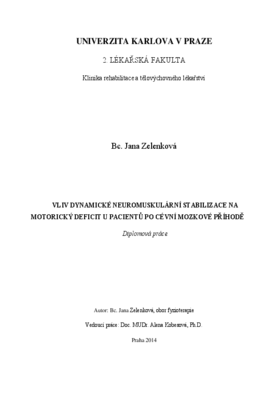Vliv dynamické neuromuskulární stabilizace na motorický deficit u pacientů po cévní mozkové příhodě
The effect of dynamic neuromusculur stabilization on motor deficit in patients after stroke
diploma thesis (DEFENDED)

View/
Permanent link
http://hdl.handle.net/20.500.11956/63046Identifiers
Study Information System: 149733
CU Caralogue: 990018567460106986
Collections
- Kvalifikační práce [1802]
Author
Advisor
Referee
Demeková, Júlia
Faculty / Institute
Second Faculty of Medicine
Discipline
Physiotherapy
Department
Department of Rehabilitation and Sports Medicine
Date of defense
3. 6. 2014
Publisher
Univerzita Karlova, 2. lékařská fakultaLanguage
Czech
Grade
Excellent
Keywords (Czech)
cévní mozková příhoda, dynamická neuromuskulární stabilizace, motorický deficit, Modifikovaná Ashworthova škála, Chedoke McMaster Stroke AssessmentKeywords (English)
stroke, cerebral pulsy, dynamic neuromuscular stabilization, motor deficit, Modified Ashworth scale, Chedoke McMaster Stroke AssessmentCílem práce bylo zhodnotit efekt specifického rehabilitačního konceptu na motorický deficit u pacientů po cévní mozkové příhodě. Tento koncept je využíván na Klinice lůžkové rehabilitace FN Motol, jeho hlavní součástí je cvičení na principech dynamické neuromuskulární stabilizace (DNS) a je založen na principech vývojové kineziologie. Do studie bylo zařazeno 12 pacientů po cévní mozkové příhodě. Probandi se účastnili tří týdenní terapie, cvičení probíhalo dvakrát denně. S využitím párového t-testu bylo dokázáno signifikantní (p < 0,05) zlepšení motorické funkce horní končetiny, ruky, dolní končetiny, nohy. Došlo k statisticky významnému zlepšení posturální kontroly a snížení bolestivosti ramene (vše hodnoceno za pomocí specifické škály: Chedoke McMaster Stroke Assessment). Modifikovanou Ashworthovou škálou byly hodnoceny změny stupně spasticity. K statisticky významnému zlepšení stupně spasticity došlo u svalových skupin: flexory loketního kloubu, adduktory dolní končetiny, extenzory kolenního kloubu a hamstringy. Bylo dokázáno, že koncept DNS je možno s výhodou použít u vybraných pacientů po cévní mozkové příhodě. Terapii je vhodné doplnit o nácvik ADL.
The aim of the study was to evaluate the effect of specific rehabilitation concept on the motor deficit in patients after stroke. This concept is used at the Department of inpatient rehabilitation FN Motol, the main component is exercise on the principles of dynamic neuromuscular stabilization (DNS) and is based on the principles of developmental kinesiology. The study included 12 patients after stroke. Probands participated in the 3 week therapy, exercise was carried out twice a day. Significant (p <0.05) improvement in motor function of the arm, hand, leg and foot was demonstrated by using Student`s paired t-test. There was a statistically significant improvement in postural control and reducing shoulder pain (all assessed using a specific scale: Chedoke McMaster Stroke Assessment). Changes in the degree of spasticity were evaluated by Modified Ashworth scale. A statistically significant improvement in the degree of spasticity was observed in these muscle groups: the elbow flexors , adductors of lower limb, knee extensors and hamstrings. It has been shown that the concept of dynamic neuromuscular stabilization can be advantageously used in selected patients after stroke. It is appropriate to supplement the DNS therapy with training of ADL.
